Beginner’s Guide to 10 Most Colorful Freshwater Fish
Published: 25 Apr 2025
Many aquarium enthusiasts struggle with choosing the right fish to bring vibrant colours to their tanks. Tanks can appear dull and lifeless without the right species, leaving hobbyists frustrated. This lack of color can impact an aquarium’s overall aesthetic and enjoyment.
Fortunately, this guide will introduce you to 10 of the most colorful freshwater fish and give tips for proper care and tank setup, ensuring your aquarium shines with vibrant life.
Setting Up Your First Colorful Fish Aquarium
Tank Size Considerations
When it comes to aquariums, bigger is usually better, especially for beginners. Larger volumes of water are more stable and forgiving of minor mistakes in maintenance:
- Minimum recommended size: 10 gallons (though 20 gallons or larger is preferable)
- Ideal starter size: 20-29 gallons
- For community tanks: 29-55 gallons
For most beginners, a 20-gallon “long” tank offers a good balance of capacity, surface area, and cost Aquarium Co-Op.

Essential Equipment
To create a healthy environment for colourful fish, you’ll need:
- Filter: Provides mechanical, biological, and chemical filtration
- Heater: Maintains stable tropical temperatures (typically 75-80°F)
- Thermometer: Monitors temperature consistency
- Light: Enhances fish colours and supports plant growth if applicable
- Water test kit: Monitors ammonia, nitrite, nitrate, and pH levels
- Water conditioner: Neutralizes chlorine and chloramine in tap water
- Aquarium gravel vacuum: For routine maintenance
The Nitrogen Cycle
Before adding any fish to your new tank, it’s crucial to establish the nitrogen cycle – the biological process that converts toxic fish waste (ammonia) into less harmful compounds:
- Set up your tank with all equipment running
- Start the cycle by adding a source of ammonia (fish food, pure ammonia, or beneficial bacteria starter)
- Test water regularly – you’ll see ammonia rise, then nitrite, and finally nitrate
- The cycle is complete when ammonia and nitrite read zero and nitrate is present
- Duration: Typically 4-6 weeks for a complete cycle
This process establishes colonies of beneficial bacteria that will process waste and keep your water safe for fish API Fishcare.
Water Parameters for Colorful Fish
Most colourful freshwater species thrive in similar water conditions:
- Temperature: 75-80°F (24-27°C)
- pH: 6.8-7.5 (neutral to slightly alkaline)
- Hardness: Soft to moderately hard water
- Ammonia & Nitrite: Always zero ppm
- Nitrate: Below 20-40 ppm
Regular water testing is essential for maintaining these parameters, especially during the first few months of your aquarium journey.
Substrate and Decorations
Your substrate choice can significantly impact how vibrant your fish appear:
- Dark substrates like black sand or dark gravel make fish colours appear more intense
- Natural decorations like driftwood and live plants provide hiding spots and create a more natural environment
- Avoid bright-coloured gravel, which can detract from the visual impact of your fish
Lighting for Vibrant Displays
Proper lighting not only keeps your fish healthy but also brings out their best colours:
- Full spectrum LED lights showcase fish colours without promoting excessive algae growth
- Colour temperature: 6500-7500K provides a balanced, natural appearance
- 8-12 hours of light daily is sufficient (use a timer for consistency)
- Avoid excessive blue light, which can stress some fish species
10 Most Colorful Freshwater Fish for Beginners
1. Guppies (Poecilia reticulata)
Appearance: Often called “million fish” or “rainbow fish,” guppies are among the most colourful freshwater species available. Males display spectacular finnage and virtually every colour imaginable, with varieties including solid colours, tuxedos, snakeskins, and cobra patterns.
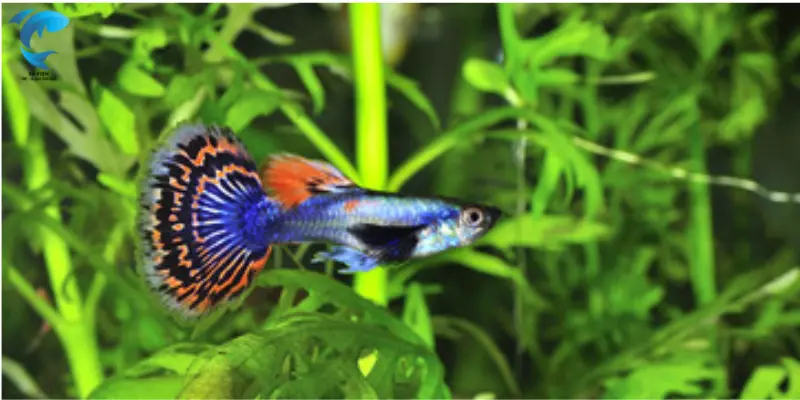
| Colour Varieties: |
|---|
|
Tank Requirements:
- Minimum tank size: 5 gallons, but 10+ gallons is better
- Water temperature: 74-82°F (23-28°C)
- pH range: 6.8-7.8
- Hardness: Adaptable, but prefers moderate hardness
Feeding: Omnivorous and easy to please. Feed high-quality flake food supplemented with occasional live or frozen foods like brine shrimp or daphnia to enhance colouration.
Temperament: Peaceful and active, making them excellent community fish. Males may occasionally display to each other, but rarely cause harm.
Special Considerations: Guppies are prolific breeders. Without intervention, a few pairs can quickly populate your tank. Consider keeping only males if you don’t want babies.
Difficulty Level: Very easy – perfect for first-time fish keepers.
Lifespan: 1-2 years with proper care Aquarium Co-Op.
2. Neon Tetras (Paracheirodon innesi)
Appearance: These small, iconic fish feature a striking electric blue horizontal stripe along their body, complemented by a vivid red stripe on their lower half. When kept in schools, their synchronized swimming creates a mesmerizing display of moving colour.
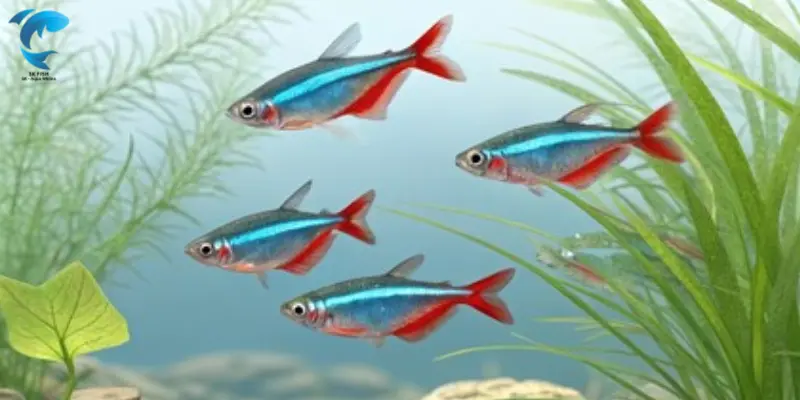
| Colour Profile: |
|---|
|
Tank Requirements:
- Minimum tank size: 10 gallons (for a small school)
- School size: 6+ fish (larger schools display better colouration and behaviour)
- Water temperature: 72-78°F (22-26°C)
- pH range: 6.0-7.0 (slightly acidic)
- Water hardness: Soft to medium
Feeding: Omnivorous. Feed high-quality flake or micro-pellet food with occasional frozen foods like daphnia or brine shrimp.
Temperament: Peaceful schooling fish that are ideal for community tanks. They prefer to be in groups and may become stressed or fail to display their best colours when kept alone or in small numbers.
Special Considerations: Neons prefer subdued lighting and planted tanks with hiding places. They are sensitive to poor water quality and sudden changes in water parameters.
Difficulty Level: Easy to moderate – requires stable water conditions.
Lifespan: 3-5 years with proper care Aqueon.
3. Betta Fish (Betta splendens)
Appearance: Also known as Siamese fighting fish, male bettas have elaborate fins and come in stunning colours and patterns. Their finery can take various forms, from the traditional veil tail to more elaborate crown tails, half-moons, and packets.

| Colour Varieties: |
|---|
|
Tank Requirements:
- Minimum tank size: 5 gallons (despite popular belief that they can live in small bowls)
- Water temperature: 76-80°F (24-27°C)
- pH range: 6.5-7.5
- Filtration: Gentle flow (bettas struggle with strong currents)
Feeding: Carnivorous. As a staple, feed high-quality betta-specific pellets supplemented with frozen or live foods like bloodworms, brine shrimp, and daphnia.
Temperament: Males are territorial and should not be kept with other male bettas or fish that resemble them. Some can be housed in community tanks with peaceful species, but temperaments vary by individual.
Special Considerations: Bettas are labyrinth fish that breathe from the surface, so tanks must have adequate surface area and air access. Males must be kept separately or with carefully selected tank mates.
Difficulty Level: Easy—good for beginners, but each fish has a distinct personality that affects its care needs.
Lifespan: 2-4 years with proper care, PetMD.
4. Platy Fish (Xiphophorus maculates)
Appearance: Platies are small, colourful livebearers with rounded bodies and active swimming behaviour. They come in various solid, variegated, and patterned colour schemes.
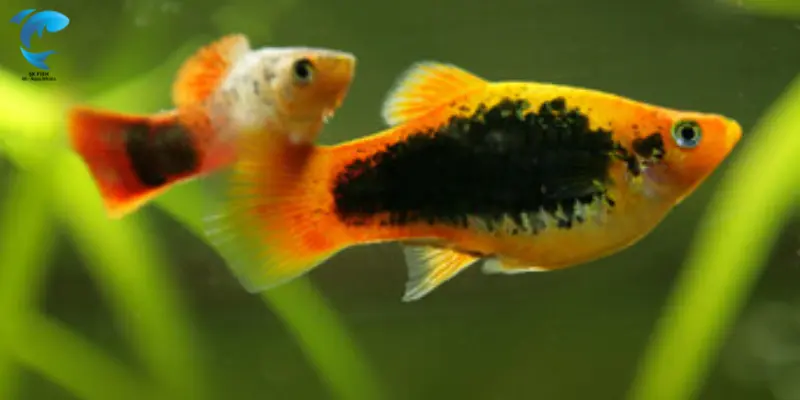
| Colour Varieties: |
|---|
|
Tank Requirements:
- Minimum tank size: 10 gallons
- Water temperature: 70-82°F (21-28°C)
- pH range: 7.0-8.2 (slightly alkaline)
- Hardness: Medium to hard water
Feeding: Omnivorous. Provide a varied diet of quality flake food, frozen foods, and occasional vegetable matter like blanched spinach or spirulina.
Temperament: Very peaceful and active. They are excellent community fish that get along with most non-aggressive species.
Special Considerations: Like guppies, platies are prolific breeders. Females can store sperm for multiple pregnancies, so even a single pregnant female can populate your tank over time.
Difficulty Level: Very easy – excellent for beginners.
Lifespan: 2-3 years with proper care Aquarium Co-Op.
5. Ember Tetras (Hyphessobrycon Amanda)
Appearance: These tiny jewels have a warm, glowing orange-red colouration, creating a stunning display, especially in planted aquariums with dark backgrounds.

| Colour Profile: |
|---|
|
Tank Requirements:
- Minimum tank size: 10 gallons
- School size: 8+ fish
- Water temperature: 73-84°F (23-29°C)
- pH range: 5.5-7.0
- Water: Soft to moderately hard
Feeding: Omnivorous. Feed high-quality micro-pellets, crushed flake food, and small live or frozen foods like baby brine shrimp or daphnia.
Temperament: Peaceful schooling fish that do well in community tanks with other non-aggressive species. They display their best colours when kept in larger groups.
Special Considerations: Their tiny size makes them unsuitable for large or aggressive fish tanks. They shine brightest in heavily planted aquariums with subdued lighting.
Difficulty Level: Easy to moderate – requires stable water conditions but otherwise hardy.
Lifespan: 2-4 years with proper care Aquarium Co-Op.
6. Dwarf Gourami (Trichogaster lalius)
Appearance: These striking fish feature brilliant blue or red bodies with vertical orange or red stripes, creating a vivid, eye-catching display.

| Colour Varieties: |
|---|
|
Tank Requirements:
- Minimum tank size: 10 gallons
- Water temperature: 72-82°F (22-28°C)
- pH range: 6.0-7.5
- Water: Soft to moderately hard
- Environment: Plenty of plants and hiding places
Feeding: Omnivorous. Offer a varied diet of high-quality flake or pellet food, supplemented with frozen or live foods like bloodworms, brine shrimp, and daphnia.
Temperament: Generally peaceful, though males may show territorial behaviour toward each other. They do well in community tanks with other peaceful species.
Special Considerations: Dwarf gouramis are labyrinth fish that breathe air from the surface, so tanks should not be covered entirely. They are susceptible to Dwarf Gourami Iridovirus (DGIV), so purchasing from reputable sources is essential.
Difficulty Level: Easy to moderate – somewhat more delicate than other beginner fish.
Lifespan: 2-4 years with proper care Aquarium Co-Op.
7. Mollies (Poecilia sphenops)
Appearance: Mollies are larger livebearers with various body shapes and colour patterns. Their elegant, flowing fins and active swimming make them attractive additions to community tanks.

| Colour Varieties: |
|---|
|
Tank Requirements:
- Minimum tank size: 20 gallons
- Water temperature: 75-82°F (24-28°C)
- pH range: 7.5-8.5 (prefer alkaline water)
- Hardness: Medium to hard water
- Salinity: Can benefit from a small amount of aquarium salt
Feeding: Omnivorous with a preference for vegetable matter. Feed high-quality flake food with algae content, supplemented with blanched vegetables and occasional frozen foods.
Temperament: Generally peaceful, though males can sometimes be territorial with each other. They are active swimmers that tend to occupy the middle to upper levels of the tank.
Special Considerations: Mollies appreciate some salt in their water (1 tablespoon per 5 gallons) and do not tolerate poor water quality. Like other livebearers, they breed readily in captivity.
Difficulty Level: Easy to moderate – requires specific water parameters.
Lifespan: 3-5 years with proper care Aquarium Co-Op.
8. Swordtails (Xiphophorus helleri)
Appearance: Named for the long, sword-like extension on the male’s tail fin, swordtails are active, colourful fish that add movement and vibrancy to any community tank.
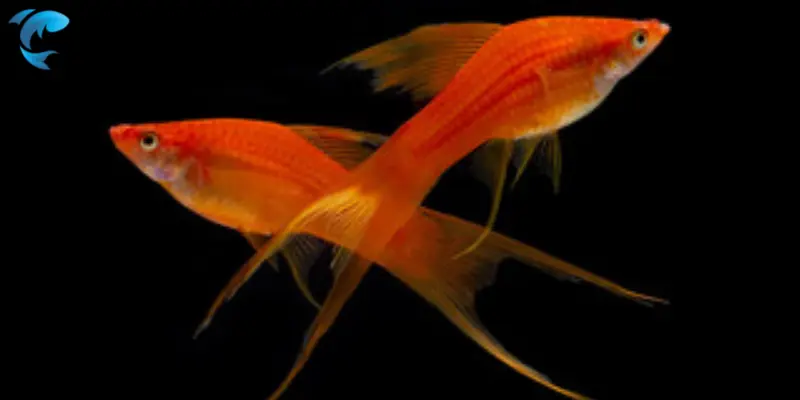
| Colour Varieties: |
|---|
|
Tank Requirements:
- Minimum tank size: 20 gallons
- Water temperature: 72-82°F (22-28°C)
- pH range: 7.0-8.2 (slightly alkaline)
- Hardness: Medium to hard water
Feeding: Omnivorous. Provide a varied diet of quality flake food, frozen foods, and some vegetable matter.
Temperament: Generally peaceful, though males can be territorial with each other. They are active swimmers who prefer tanks with open swimming areas and planted zones.
Special Considerations: Males can sometimes harass females, so keeping a ratio of at least two females to each male is recommended. Like other livebearers, they breed readily.
Difficulty Level: Easy – hardy and adaptable.
Lifespan: 3-5 years with proper care Fish Lore.
9. Cherry Barbs (Puntius titteya)
Appearance: When mature, male cherry barbs develop a stunning cherry-red colouration, creating a beautiful contrast in planted tanks. Females are more subdued, with a golden-brown or olive colour.

| Colour Profile: |
|---|
|
Tank Requirements:
- Minimum tank size: 20 gallons
- School size: 6+ fish
- Water temperature: 74-79°F (23-26°C)
- pH range: 6.0-7.0
- Water: Soft to moderately hard
Feeding: Omnivorous. Feed high-quality flake or small pellet food supplemented with frozen or live foods like bloodworms, brine shrimp, and daphnia.
Temperament: Peaceful schooling fish that occasionally display minor chasing behaviour within the group. They are excellent community fish that do well with other peaceful species.
Special Considerations: Males show their best colours when kept in groups with females and housed in tanks with darker substrates and plenty of plants.
Difficulty Level: Easy – hardy and adaptable.
Lifespan: 4-5 years with proper care Fish Lore.
10. Celestial Pearl Danios (Danio margaritatus)
Appearance: These tiny gems, formerly known as galaxy rasboras, feature a dark blue to black body covered with pearly white dots reminiscent of a starry night sky. Males display brilliant red-orange fins.
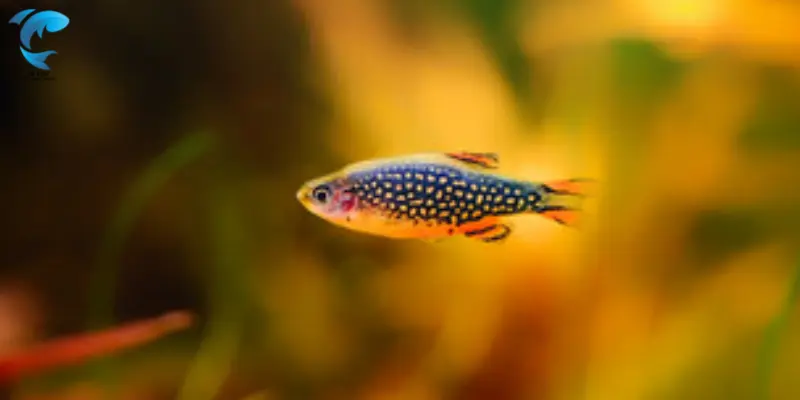
| Colour Profile: |
|---|
|
Tank Requirements:
- Minimum tank size: 10 gallons
- School size: 8+ fish
- Water temperature: 73-79°F (23-26°C)
- pH range: 6.5-7.5
- Water: Soft to moderately hard
- Environment: Densely planted with hiding places
Feeding: Omnivorous. Feed high-quality micro-pellets, crushed flake food, and small live or frozen foods like daphnia, cyclops, or baby brine shrimp.
Temperament: Shy but peaceful. They do best in species-specific tanks or with other small, peaceful fish. They need time to acclimate to new environments and may hide initially.
Special Considerations: Their small size (under 1 inch) makes them vulnerable to larger fish. They prefer densely planted aquariums with plenty of hiding spots and subdued lighting.
Difficulty Level: Moderate – requires stable water conditions and appropriate tankmates.
Lifespan: 3-5 years with proper care Aquarium Co-Op.
Maintaining Vibrant Colors in Your Fish
Diet for Enhanced Coloration
What you feed your fish significantly impacts their colouration:
- Colour-enhancing foods: Look for foods containing natural colour enhancers like:
- Astaxanthin
- Canthaxanthin
- Spirulina
- Krill
- Live and frozen foods often contain natural pigments that intensify fish colours:
- Bloodworms
- Brine shrimp
- Daphnia
- Black worms
- Fresh vegetables can boost colour in omnivorous species:
- Spinach
- Peas
- Zucchini
- Cucumber
Feed a varied diet rather than relying on a single food source, FishLore Forum, for best results.
Water Quality Management
- Clean, well-maintained water is essential for vibrant colours:
- Regular water changes: 25-30% every 1-2 weeks
- Filter maintenance: Clean according to the manufacturer’s guidelines without destroying beneficial bacteria
- Water testing: Monitor ammonia, nitrite, nitrate, pH, and hardness weekly
- Avoid overcrowding: Follow the inch-per-gallon rule (with adjustments for fish mass)
Fish under stress from poor water quality will not display their optimal colouration.

Lighting Techniques
Strategic lighting can dramatically enhance how your fish appear:
- Full spectrum lighting: Provides balanced illumination that showcases natural colours
- Adjustable RGB LEDs: Allow fine-tuning of the light spectrum to improve specific colour tones
- Darker backgrounds: Create contrast that makes fish colors pop
- Timed lighting periods: Consistent photoperiods of 8-10 hours help maintain natural behaviours
Health Considerations
Healthy fish display the best colours:
- Quarantine new arrivals: Prevent the introduction of disease
- Observe regularly: Watch for early signs of stress or illness
- Maintain proper nutrition: Undernourished fish lose color intensity
- Create appropriate social groups: Many fish show better colouration when kept in proper schools or communities
Common Beginner Mistakes and How to Avoid Them
| Skipping the Cycling Process |
|---|
Mistake: Adding fish to a brand-new tank before establishing beneficial bacteria. Solution: Always cycle your tank (4-6 weeks) before adding fish, or use a “fish-in” cycle with careful monitoring and minimal bioload. |
| Overstocking the Tank |
|---|
Mistake: Adding too many fish too quickly overwhelmed the biological filtration. Solution: Stock slowly (a few fish at a time), allowing the biological filter to adjust. Research appropriate stocking levels for your tank size. |
| Inconsistent Water Changes |
|---|
Mistake: Neglecting regular water changes or performing massive water changes infrequently. Solution: Establish a consistent schedule of more minor water changes (15-25% weekly or biweekly). |
| Overfeeding |
|---|
Mistake: More food than fish can consume in a few minutes leads to water pollution. Solution: Feed small amounts 1-2 times daily that can be consumed within 2-3 minutes. Fast from fish one day per week. |
| Poor Acclimation |
|---|
Mistake: Adding new fish directly to the tank without acclimating to the new water parameters. Solution: Use the float-and-drip method over 30-60 minutes to gradually acclimate fish to your water conditions. |
| Incompatible Tank Mates |
|---|
Mistake: Combining fish with conflicting temperature requirements, aggressive tendencies, or size differences. Solution: Research each species thoroughly before purchasing, and create a stocking plan with compatible fish. |
| Incorrect Water Parameters |
|---|
Mistake: Trying to keep fish in water conditions outside their preferred ranges. Solution: Choose fish that match your local water parameters or adjust water to suit specific species’ needs. |
| Insufficient Research |
|---|
Mistake: Purchasing fish on impulse without understanding their specific needs. Solution: Research any fish before buying—learn about its adult size, temperament, diet, and environmental requirements. |
Conclusion and Next Steps
Successfully keeping colourful freshwater fish is both rewarding and achievable for beginners who take the time to learn proper care techniques. By starting with the correct setup, selecting appropriate fish species, and maintaining consistent care routines, you can enjoy a vibrant aquatic display that brings life and colour to your home.
As you gain experience, you might consider:
- Expanding to larger tanks with more diverse communities
- Trying planted aquariums to create natural environments that enhance fish colours
- Breeding projects for species you particularly enjoy
- Specialized setups for particular biotopes or fish types
Remember that fishkeeping is as much an ongoing learning experience as it is a hobby. Each species has unique characteristics and care requirements, and part of the joy comes from the continual discovery and deepening appreciation of the underwater world.
Additional Resources
For further learning, consider:
- Local aquarium clubs
- Fish-specific online forums
- Aquarium-focused YouTube channels
- Books on freshwater fishkeeping
- Visits to well-maintained local fish stores
Most importantly, enjoy the journey of creating and maintaining your underwater world of colour!
FAQ: Most Colorful Freshwater Fish
The most colourful freshwater fish are a sight to behold, known for their vibrant hues and patterns that can vary from species to species. Some of the most popular and colourful freshwater fish, each a unique masterpiece of nature, include Betta Fish (Betta splendens), known for their vibrant reds, blues, and purples.
- Neon Tetras (Paracheirodon innesi): They display a brilliant blue body with a red stripe along their sides.
- Guppies (Poecilia reticulata): These small fish come in various colours, including yellow, red, blue, and orange.
- Discus Fish (Symphysodon spp.): They are often bright blue, red, or orange, with intricate patterns.
- Cichlids (various species): Cichlids, like the Electric Blue Acara, display stunning, bright colours. These species are famous for their dazzling appearance, making them popular among aquarium enthusiasts.
Caring for colourful freshwater fish requires a few key considerations:
- Tank Size: Make sure the tank is large enough for the species. Betta Fish do well in smaller tanks, while species like Discus require more space.
- Water Quality: Regular water changes and maintaining stable temperature and pH levels are critical. Use a sound filtration system to keep the water clean.
- Diet: Feed your Fish a balanced diet. High-quality fish flakes or pellets can be used, with occasional treats like frozen or live food.
- Lighting: Proper lighting enhances the colours of your Fish. Avoid harsh lighting that can stress them out, and opt for a gentle, natural light cycle.
- Tankmates: Some colourful fish, like Betta Fish, are territorial and should be housed alone, while others, like Guppies and Neon Tetras, can thrive in schools with compatible species.
Yes, different species of colourful freshwater fish often have unique water condition requirements:
- Temperature: Tropical Fish, like Betta Fish and Neon Tetras, require warmer water temperatures (between 75-80°F or 24-27°C).
- pH Level: Most freshwater fish prefer slightly acidic to neutral water (pH 6.5-7.5), but some species, such as certain cichlids, may prefer slightly alkaline water.
Hardness: Fish like Guppies thrive in moderately complex water, which means water with a moderate amount of dissolved minerals, while species like Discus prefer softer water, which has a lower mineral content. Regular testing of your water’s pH, hardness, and temperature is essential to ensure the health and vibrancy of your colourful Fish.
Absolutely! Many colourful freshwater fish are not only stunning but also ideal for beginners. Fish like Guppies, Neon Tetras, and Betta Fish are relatively easy to care for and can tolerate various water conditions, providing a great starting point for your aquarium journey.
Yes, many colourful freshwater fish can be bred in an aquarium. However, breeding success depends on the species and the conditions you provide:
- Guppies and Neon Tetras are relatively easy to breed in a home aquarium if you provide the right environment, like a breeding tank with hiding spots for the fry (baby fish) and a stable water temperature of around 78°F (25.5 °C). Betta Fish breeding requires more effort, including setting up a specific breeding tank with a bubble nest and ensuring proper care for the fry after they hatch.
- Discus Fish require precise water conditions and are more challenging to breed at home. Researching the specific breeding habits of your chosen Fish is essential for success.

SK Fish is your trusted source for practical fish care tips and delicious seafood recipes. Our team is dedicated to providing reliable, well-researched content for fishing enthusiasts and home cooks alike.

- Be Respectful
- Stay Relevant
- Stay Positive
- True Feedback
- Encourage Discussion
- Avoid Spamming
- No Fake News
- Don't Copy-Paste
- No Personal Attacks



- Be Respectful
- Stay Relevant
- Stay Positive
- True Feedback
- Encourage Discussion
- Avoid Spamming
- No Fake News
- Don't Copy-Paste
- No Personal Attacks





